
Battle of Gaugamela
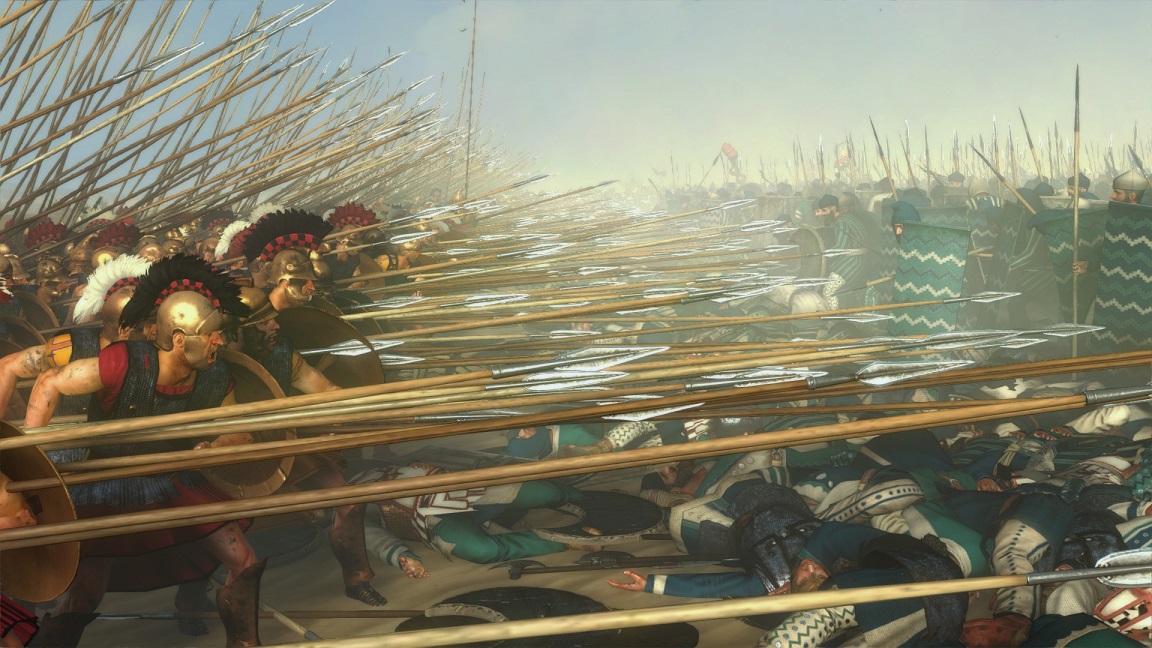
Battle of Gaugamela - 1 October 331 BC
Two years after the triumph of Issus, Alexander destroys the last great Persian army led by Darius III, opening the way for the conquest of Asia.
Opponents
Parmenion (CA. 400 BC - ? Ecbatana 330 BC)
General in the service of Philip II of Macedon and Alexander the great. During the reign of Philip II Parmenion obtained a great victory over the Illyrians in 356 BC, was one of the delegates appointed to conclude peace with Athens in 346 BC, and was sent with an army to uphold Macedonian influence in Euboea in 342 BC.
Parmenion was the most trusted General of Philip II, and had a major influence in the formation of the hard, disciplined and professional Macedonian army whose tactics would dominate the Hellenistic world for centuries, probably until the battle of Pydna versus Rome in 168 BC.
To Parmenion is generally recognized an important part in the introduction of the use of the Sarissa in the Macedonian phalanx, making it devastating against the Hoplites infantry, and so to realization of Philip's dreams of power.
After Alexander was recognized King of Macedonia, Parmenion himself became second in command of the army and his suggestions seem strongly influenced the tactical vision. For example, according to the text "Anabasis of Alexander" by Lucius Flavius Arrian, at the Granicus Parmenion suggested to delay the attack, since the army had already marched all day and also taking in consideration other political and geographical reasons. It seems that Alexander attacked across the River, bypassing the Council and gaining a victory. However, Diodorus Siculus, clearly contradicts Arrian when report that Alexander accepted Parmenion's advice. In any case, the result would be due by the youthful effrontery of Alexander, as he proceeded with caution in the following six months when, once liberated Greek cities in Asia minor, showed a change in his aggressiveness.
However, it is indisputable that Parmenion continued to have a significant influence and remained one of the protagonists of that campaign until the conquest of Babylon, after having led the left wing Macedonian both at Issus and Gaugamela (remember that the left was an essential part within the Macedonian military system, which allowed the King to find the time and the means to strike the decisive blow).
After the conquest of Drangiana, Alexander was informed that Philotas, son of Parmenion, was involved in a plot against his life. Philotas was condemned and killed, and Alexander, thinking that it could be dangerous to his safety, allowing the father to live, after the execution, sent the order for the assassination of Parmenion. There was no proof that Parmenion was in any way involved in the conspiracy, but did not even have a chance to defend themselves. On the other hand we can say, in defence of Alexander, that Parmenion "disappointed" was a serious threat to the King, especially since he was at the head of a considerable part of the army assigned to the spoils of war by itself and its supply lines. Also, as father of Philotas, Parmenion was responsible for his son's actions, despite the lack of hard evidence. So Alexander decided quickly, to send three officers who crossed the desert on camels and stabbed him to death on the spot.
Bessus (? - died summer 329 BC)
Was an important Bactrian satrap and self-proclaimed King of Persia. According to the classical sources, was responsible for the death of his predecessor, Darius III, after the Persian army had been defeated by Alexander the great at Gaugamela. At the battle of Gaugamela, Bessus commanded the left wing of the Persian army, composed primarily of troops of his satrapy, which was mobilized even before the battle of Issus. Despite the failed encirclement ordered by Darius and the continuation of fierce fighting, he survived and gone, at first, with its King, following the route of the Persian army that escaped from Alexander's forces and spending the next winter at Ecbatana. Thereupon, Bessus, conspired with other satraps, deposing Darius III, probably convinced that Alexander, after receiving the news of the arrest of Darius, would stop his March.
According to the sources, the conspirators mortally wounded Darius III and abandoned his corpse, in such a way as to be found by a Macedonian soldier in July of 330 BC, in a place that was located near modern Ahuan.
Bessus immediately proclaimed himself King adopting the name of Artaxerxes. His self-proclaimed ascension was logical, since the satrap of Bactria, known as Mathista, was the next noble in the list of succession to the Persian throne. But since most of the Persian Empire had been conquered and Bessus only ruled over a loose alliance of "free provinces", historians generally do not consider it officially a Persian King.
Bessus returned to Bactria trying to organize a resistance among the Eastern satraps, but, frightened by the approaching Macedonians, the people arrested and handed over him to the Macedonian King Alexander. So Alexander ordered that noses and ears of Besso were cut, according to a Persian costume used for those involved in rebellion and regicide.
At this point the ancient sources on the death of Bessus are contradictory. According to some sources, it seems that he was crucified in the place where Darius III had been killed, while Arrian reports that he was tortured and then beheaded at Ecbatana; finally, Plutarch suggests that he was torn apart in Bactria, after a "process" held by Macedonian conquerors.
Between Issus and Gaugamela
On October 1, 331 BC was one of the decisive battles of history. The battle of Gaugamela was the culmination of the campaign of Alexander. Beated in his first encounter with Alexander at Issus (333 BC), Darius III, to avoid another war, offered him all regions West of the Euphrates, a high ransom to regain his harem (which the Macedonian had captured at Issus) and his daughter. But Alexander refused. Its purpose was to conquer the entire Achaemenid Empire. Alexander then moved to Syria, Phoenicia and the city of Tyre, which surrendered to him in 332 BC after eight months of resistance; 8000 of its inhabitants were killed and 30,000 made slaves. After Tyre, Gaza fell and after Gaza was the turn of Egypt. Now in the area of delta Nile, Alexander founded Alexandria, celebrated the games according to the Greek costume, made sacrifices to the Egyptians gods and was proclaimed King of Egypt.
He visited the Oracle of Ammon (which became "Zeus-Ammon" for assimilation with the Greek deity) at oasis of Siwa, in the Libyan desert. The pilgrimage to this sanctuary was, and still is, particularly difficult and dangerous. Alexander went there and never revealed the reasons of his questions, although, as far as we know, is said to be satisfied with the divine responses. His soldiers subsequently thought that probably their leader had asked if he would rule the world, and if all his father's killers were found and killed. It may well be that the Oracle gave confirmation to his secret desire to be able to boast a divine origin, that his real father was the same Zeus-Ammon. Alexander then turned towards the Interior of Asia, crossed the Euphrates in 331 BC, and then the Tigers to confront Darius III. He decided to wait until the great King had not enlisted even the last Persian; the Macedonian King wanted to make sure, after this clash, that no other battles will be required.
Accomplished this huge assembly operation, Darius patrolled around looking for a suitable battlefield. He wanted to take advantage of its numerical superiority to force Alexander to give battle in the vast plains of the Tigris. The King then ordered to one of his officers to stand guard, but, at the approach of the enemy, to let him pass undisturbed. Alexander and his army in fact crossed the Euphrates unscathed. Darius left Babylon towards the North and at Arbela did built his camp. So dispose his army in the plains between the Tigris and the Zab, plains who had made free from any obstacle, so he can use his famous scythed chariots.
Alexander was targeting the heart of Mesopotamia, and at Thapsakos he led his army across the Euphrates, then moved to Northeast. As soon as he was aware that the Persian army had come to the battle and camped just a few days of march southwards, in the plains of Gaugamela, Alexander ordered to prepare his own camp.
Counting on the advantage of numerical superiority on the ground, scythed chariots, war elephants and a large military force, Darius felt confident of victory. But, given that the Persians were afraid of a night attack of Macedonians, he ordered to all men to stay awake and be ready to react. Parmenion planned a night attack, but Alexander preferred to spend the night preparing his plan, allowing the men to rest. The plan included some news in the lineup.
The Scythed chariots
The scythed chariots that the Persians deployed at Gaugamela was a chariot with sensitive changes compared to that used by the Egyptians and Hittites many centuries before. It was fitted with a metal blade on the head and on the rudder, on the hubs of the wheels and at the banks: these were extended horizontally for a meter around on each side of it. This really made it a fearsome weapon: once launched in speed by the rapid caparisoned horses towards the enemy lines, was the massacre of everything it encounter. The Greek General Xenophon (430-354 BC), an eyewitness to the battle of Cunaxa, says about this chariots: «these chariots had a thin scythe that extends at an angle from the pivot and also under the driver's seat, turned towards the ground». However according to Nefiodkin, the attribution made by Xenophon, that Scythed chariots were used already by the first Persian King Cyrus, may be incorrect, considering their absence in the invasion of Greece (480-479 BC) led by his successor, Xerxes. He argues, instead, that the Persians introduced the Scythed chariots in a period subsequent to the greek-Persian wars, between 467 BC and 458 BC, as an alternative solution, considering the previous fighting "experience" against Greek heavy infantry.
The Scythed chariots, usually pulled by four horses, had a crew of three men, a charioteer (driver) and two warriors.
Theoretically, the Scythed chariots was used as a means to break through the enemy infantry lines with shock action; it was launched at full speed against the opponent causing the cutting in half of enemy fighters that encountered or at least opening gaps in the enemy line which could then be exploited to break the formations. In that era, when cavalry was not yet in use the brackets and probably neither spurs nor an effective saddle were utilized, scythed chariots were deemed the most effective weapon for an attack against infantry. In fact, while for the cavalry was difficult to keep the horses gallop and hit with all their strength the Hoplite phalanx formation of the Greek and Macedonian without the danger for the Knights to be tossed from the saddle, the scythed chariot could partly avoid this problem, and, thanks to the action of cutting blade which was armed, was somewhat effective even when the horses avoided men of the enemy formation.
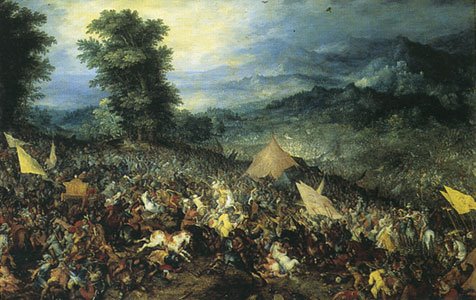
However a well trained army could diverge when the chariot was approaching, creating spaces through which it pass, then close quickly in close formation behind it, allowing the chariot to cross the formation without causing many casualties. In addition, scythed chariots, used strictly as an offensive weapon against infantry, required a large and flat battleground to be used, considering that the charioteers needed a lot of space to maneuver. Therefore, from the 3rd century BC were supplanted by the Cavalry, more maneuverable and flexible (the first to use optimally the cavalry and the main weapon of its army was Hannibal).
According to some historical sources scythed chariots were used, in rare occasions, even by Greek and Roman.
The scythed chariot soon revealed itself as a weapon with limited tactical advantages. An example of the ineffectiveness of the Persian scythed chariot was during the clash with the Macedonian phalanx led by Alexander the great. Realizing that the chariots were an element of hindrance difficult to manage for the Persian army under Darius III, he instructed his warriors to increase this disadvantage. Shortly before the tanks come into contact with the infantry, the Phalanx would have quickly moved in an enveloping formation (in an "E" formation, where the intermediate section of the letter represents the chariot) to trap the chariots in the ranks of the Macedonian soldiers and their Sarissa. This was the particular tactic used successfully in the battle of Gaugamela.
Alexander's army
The army of Alexander the great was composed of different types of units (heavy and light infantry, heavy and light cavalry) that were used on the battlefield, each according to its own characteristics and the type of armament. We have already examined (Battle of Issus) Hypaspisti and the formation of the Macedonian phalanx, that here we will now summarize so briefly, let us therefore to observe in more detail what were the other members of the Alexander army.
The Macedonian phalanx was characterized by Sarissa, a long spear of approximately 4.30 meters; the deployment was rectangular with a depth of 16 lines and with some light infantry at the center of the grid; It was subdivided in units equivalent to regiments, the taxeis, 1500 men each, subdivided into locoi, companies. Along the front rows were sarissas stakes horizontally in front of the Phalanx, while those on the backward companions were held aloft, so the Macedonian phalanx was terrible for the lance that protruded on its forehead, deadly for the approaching enemy.
The infantry units of Hypaspisti were chosen Hoplitic Guards Corps, with special prowess, intended to strengthen and drag the normal line infantry of the Phalanx. They had a shield similar to the Peltasts one, or a small round pelta, and their armament consisted of, in addition to the shield, a helmet, a cuirass, greaves, a sarissa (shorter and manageable) and a sword. It did not differ substantially from that of pezetairoi (foot soldiers in heavy armor). They were especially effective in defence as in destroying enemy heavy infantry units, thanks to their greater ability to maneuver in the formation.
Greek Hoplites (Heavy infantry): this was the traditional Greek infantry, who fought mainly in phalanx formation, 8 men deep, again divided into taxeis of 1500 each. Alexander, as a "hegemon" (Commander) of the Greek League, had these troops from the various Greek city-States that had, although reluctant, "ally" with him. They were more heavily armoured than their Macedonian counterparts, with helmets and greaves in addition to a full plate armor. Their Pikes/Spears were shorter, one-handed weapons, with a length of about 2.5 -3 metres; This allowed them to use a large bronze shield, connected to the arm with two belts, at the elbow and the wrist. Their fighting method was different from that of the Macedonians regiments and Alexander did not used as first-line troops. At Gaugamela, the Hoplites formed the second line of infantry and were responsible for the reverse of the "box".
Agrianes javelin throwers (Light infantry troops-skirmish units): these units consisting of 500 men each, were formed by men of the wild tribes of a remote area of Macedonia. Apparently, constituted one of the Alexander preferred units. Their armor, if employed, was small. Usually used javelins and swords and a shield small and lightweight. They fought in a specific formation, but engaged intact enemy forces continuously or pursued those fleeing. Although lightly armed, were often surprisingly effective in impact situations; ideally took their main task at Gaugamela counterattacking the Persians chariots.
Archers (Skirmish troops and, very occasionally, light infantry) in units of 500 men, archers of Alexander's Army consisted of indigenous Macedonian and Cretan mercenaries. Obviously not wearing armor, carried swords but they were not trained to deal with hand-to-hand combat.
Hetairoi (Heavy cavalry) Cavalry: Hetairoi units were mainly formed by the Macedonians and followers of the King (companions). The eight "ilai" (squadrons) were composed of about 200-300 men each (after 330 BC every "ile" will be split into two companies). During the battle of Gaugamela, some Greeks replaced the Macedonians who fell during the long campaign of Alexander. The elite units of this corp, the other side of the agema (as the already mentioned Hypaspisti), rode with the same Alexander. They wore metal armour and helmets, sometimes with plates fixed to the upper arm. Used pelta and a weapon known as "xyston", a spear made of Cornel wood with a blade at each end, 3.5 meters long and manageable with one hand. After the initial charge, if spear was broken, was abandoned, otherwise it was throwned in order not to unseat the knight, who then used the sword (Kopis). This Cavalry used often a "wedge-shaped" formation with tip directed towards the enemy. Although unable to a direct assault on the enemy heavy infantry could easily exploit the opening, bringing deadly attacks on the flanks or back. Their role at Gaugamela was typical, Alexander wanted to ensure they were at the top of the action, riding with them. Perhaps the most glaring example of this importance was at the battle of Granicus, Alexander led an incredibly reckless charge across the River, against the enemy center.
The Thessalians (Heavy cavalry): the Thessalians, a conquered people that had been "assimilated" into the Macedonian Kingdom was rich enough to afford horses and armor necessary to form Heavy Cavalry units. They were similar to the Hetairoi and seconds to them only for reputation. Their elite units consisted of some of the richest noblemen of Thessaly. Wearing the breastplate and helmet, such as Hetairoi, they handled two lance long 2.5 meters (one to be thrown) and swords used after the charge. Thessalians fought in closed formation, preferring at rhomboid shape wedge ethers. At Gaugamela, as in many other battles, were placed at the left wing of the army of Alexander.
Lancers (Light cavalry): these "prodromoi" (explorers), were composed entirely of native origin Macedonians, although were accepted some Greeks among their number at the time of Gaugamela. They were organized in units of about 300 men each, armed with long sarissa, maybe longer than the Hetairoi one, so they were known as "sarissophoroi". They wore a small breastplate and had no chance to throw anything. Were the protagonists of one of the key actions at Gaugamela, breaking the link between the enemy center and their left wing.
Javelin throwers Paeonians and Thracians (Light cavalry): these units, divided into "ilai" of 200-300 men, were composed by the tribe within the Kingdom of Macedonia. The Greek Allied Cavalry supplied to Alexander from the City-State was similar in composition to these devices. Not wearing any armor, they were equipped only with javelins, long knives and fought in open order. With a role similar to the agrianes infantry, their purpose was to harass the enemy not yet broke and pursue the retreating opponents; they had no effect in impact actions. It is known that the Paeonians, at least, had shields.
The opposing forces
Alexander's Army consisted of 40,000 infantry and 7,000 cavalry. Compared to the Persians, Alexander was in numerical disadvantage, but his army was largely formed from veterans accustomed to war; a short chain of command would have been an advantage in battle. The Macedonian army consisted of Hetairoi and Hypaspisti cavalry armed with lances, armed similarly to Hoplites, but less limited in movement. Alexander also had Pezeteri, armed with long pikes, and the usual troops with light weaponry. Philip, the father of Alexander, had assembled a powerful army, on which his son could now count. Alexander's Army was joined by many allies and soldiers from Greece and the whole Balkan region.
After the defeat at Issus, Darius had had nearly two years to form an army. To achieve numerical superiority recruited every male fighter of his empire. But many of these soldiers were too young or not at all prepared for the war, which eventually led to a mass panic. The King's Army consisted of many different tribes mixed together - infantry and knights from Mesopotamia, Babylon and the coast of the Persian Gulf. It included, at least, 250,000 men, of which 30,000 Greek soldiers and 12,000 bactrians horsemen with heavy armament. Unlike the rest of the army, the cavalry consisted of many experienced fighters, the best reclutabile cavalry from his Eastern satrapies and from an Allied Scythian tribe; its nucleus, the kara was permanently in service. The Indians put at its disposal 15 War Elephants for battle; it also featured the use of 200 scythed chariots, that should break the Macedonian phalanx during the battle. In addition, there were the Royal Guard and the unit of Greek hoplites.
The battle
Before the start of the battle the Persians were already deployed on the battlefield. Darius, to support the charge and increase the effectiveness of his chariots, had prepared the ground in front of his troops by removing shrubs and bushes. In support of the scythed chariots there were also 15 Indian elephants, although it seems that they have not had a decisive role in the battle.
Then the chariots were positioned in front of the line with a small group of Bactrians knights. The cavalry was deployed on two wings: Bessus commanded the left wing, where were the Bactrians, Daha, Aracrosiani, Persians, Susi, Cadusii and Scythians; Mazaeus commanded the right wing, composed of Siri Knights, Mesopotamian, Medes, Parthians, Saka, Tapuri, Hyrcanian, Cappadocian, Sacesini, and Armenians. The Cappadocians and Armenians were deployed in front of the other cavalry units and led the attack. The Albani Knights receive the order to expand so to hit the left side of the Macedonians. Darius positioned himself at the center of his army, surrounded by his best troops, as was the tradition for the Persian Kings. On the right were the Carians, the Greek mercenaries and the Persian Horse Guards. Between the center and the right wing of the formation arranged the Persian infantry Guards (the famous Immortals), the Indian cavalry and Mardiani archers.

The Macedonians were divided into two, with the right side of the army under the direct command of Alexander, and the left to Parmenion. Alexander fought with his chosen Knights, accompanied by Paeonians and Macedonian light cavalry. Parmenion with the Thessalian, Greek mercenary, and Thracian Cavalry units. They were deployed in that site with the orders to carry out a manoeuvre, while Alexander would have dealt the decisive blow from the right. Mercenary cavalry was divided into two groups, with the veterans laid out on the right flank and the other in front of the Agrianes and the Macedonian archers which were flanking the Phalanx.
Between the center and the right wing of the formation were Cretan mercenaries. Behind them was a group of Thessalian Cavalry, commanded by Philip, and Achaeans mercenaries. To their right was another part of the Allied Greek Cavalry. From there it moved the Phalanx, which was placed on a double line. Since the numerical gap between the chivalries was 5 to 1, and the line formed by the Persians exceeded by over a mile the phalanx, seemed inevitable that the Macedonians were taken on the flanks by the Persians. The second line had its orders to fight any enemy unit that had accompanied them. This second line consisted mainly of mercenaries.
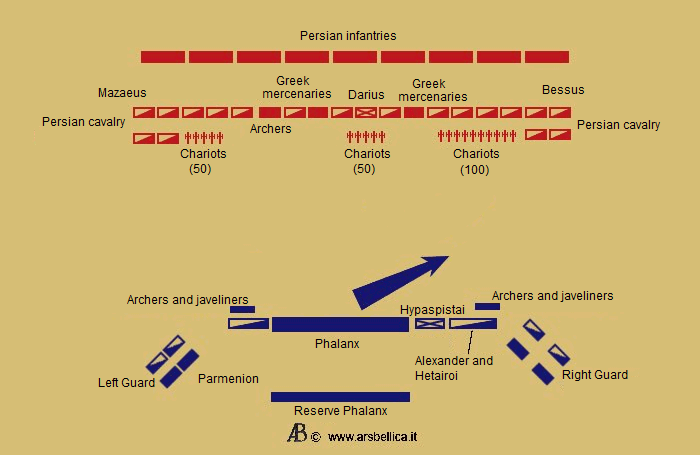
Alexander's strategic plan was to engage chivalries flanks in order to create a gap between the enemy lines through which could be launched a decisive attack in the center against Darius. This plan required a perfect maneuver capability and timing, and would work only if the great King had attacked first. Then the Macedonians advanced slowly to the right with staggered wings, arranged to form angles of 45° backwards, so as to invite the Persian Cavalry to attack.
Darius won't to attack first, still having in mind what had happened at Issus against a similar formation, but in the end, as they would soon exited from the "prepared" field, was forced to attack. So Darius launched then his chariots, some of which were intercepted by the Agrianians, and by cavalries.
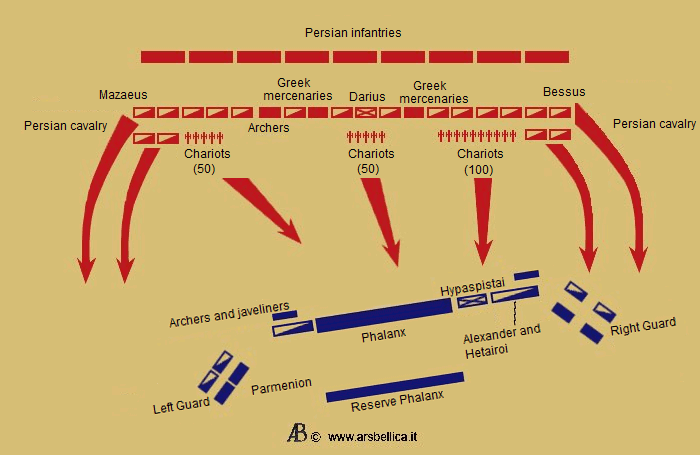
The Macedonian army had been trained at a new tactic to contrast the devastating Persian scythes chariots attack, when the chariots had arrived nearly on contact, the first lines should move sideways, opening a gap. The horses were rejected to crash against the more advanced sarissas line and come in the space created between the lines so to stop when facing the second sarissas lines, being trapped. The chariots soldiers would then been killed easily. In this way, the Macedonians neutralized the Persian attack.
While the Persians were attacking on the flanks of the Macedonians, Alexander slowly slid into his rear. The Persian manoeuvre opened a gap between the left wing of Bessus and the center, just when Alexander moved in action his last reserves on horseback. Thereupon, Alexander ordered his personnel cavalry to withdraw to prepare for the decisive attack. Continuing the march, he deployed his units as to form a giant arrow, whose tip was himself. Behind him was his personal Cavalry, then all phalanx battalions that he could subtract at the battle.

Meanwhile, as the Macedonians trying to stem the offensive on the left side, a gap opened up in their lines, between the left wing and center. The Persian Cavalry units positioned in the center and Indian with Darius broke into this gap but, instead of attacking the Phalanx or Parmenion from behind, went to the enemy camp to raid.
The rear phalanx began pursuing the Persian chivalries directed to the camp. Alexander attacked the Persians at the center, where they were more unprotected, chasing away the Royal Guard of Darius and the Greek mercenaries. Bessus, on the left, found himself separated from Darius and, fearing to being attacked from that formation, began to withdraw its troops. Even Darius could remain isolated: thereupon, the various sources differ on what happened. According to the most popular opinion, Darius routed and fled, and the rest of the army followed him.

But the only contemporary source, a Babylonian astronomical diary written in the days of the battle, says: The twenty-fourth [day of the lunar month] in the morning, the King of the world [i.e., Alexander] [has established its] order. Opposed to each other, fought and a heavy defeat of the troops [of the King was inflicted by him]. The King [i.e., Darius], his troops have abandoned him and to their city [returned]. Have fled to the land of Guti. Diodorus agrees with this version, confirming its validity. It would seem the most likely account of the battle.
Thereupon, Alexander was unable to pursue Darius because he received a request for help from Parmenion (an event that would be used later by Callisthenes and others to discredit Parmenion). Mazaeus also began to withdraw its forces, as did Bessus. However, unlike the latter, Mazaeus and his troops were disunited and, while fleeing, were charged by the Thessalians and other Macedonian cavalry units.
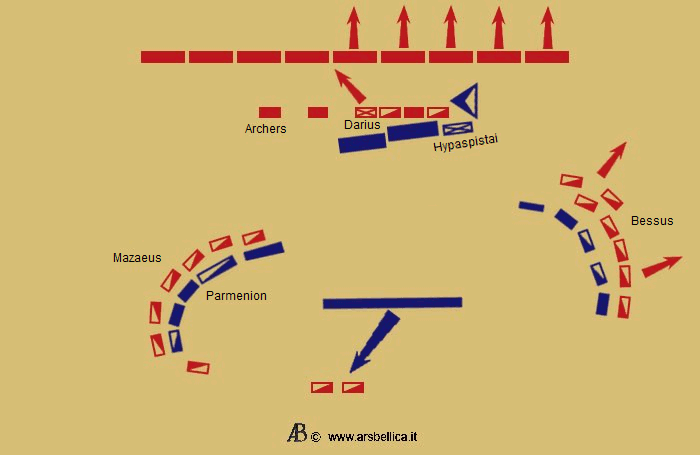
At the end of the battle, the Macedonians counted among its ranks more than 1,200 killed and wounded; casualities among the Persians were about 53,000.
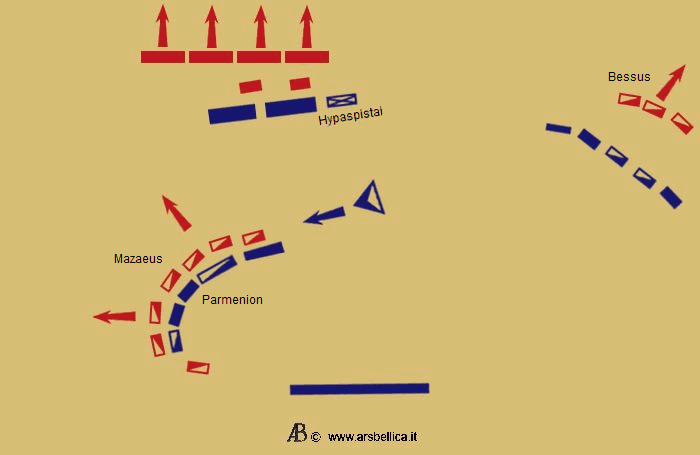
The consequences
As at Issus, substantial amounts of loot were gained in the minutes that followed the battle, the Macedonians gained probably 4,000 talents of the King's personal chariot and much of the war elephants. In the end, it was a disastrous defeat for the Persians, and perhaps one of the most beautiful victories of Alexander. Darius had managed to flee from the battle with a small nucleus of his remaining forces: part of the Bactrian cavalry and Bessus, some of the survivors of the Royal Guard and 2,000 Greek mercenaries. But, at this point, the Persian Empire was divided into two halves: East and West.
During his escape, it seems that Darius has gave a speech to what remained of his army. He planned to stand up to the Macedonians to the East, raising another army, while they were on their way to Babylon. At the same time he sent letters to his Eastern satraps asking them to remain loyal. The satrapies, however, had other intentions. The same Bessus, next to him in the escape after the defeat, killed Darius, before fleeing eastwards.
Alexander persecuted Bessus, until his capture and execution the following year, so, most of the existing satraps expressed their allegiance to Alexander, being authorized by the same Macedonian Kings to keep their government positions.
However, despite this move showed the attempt to maintain the institutional continuity by Alexander, the Persian Empire is traditionally considered fallen with the death of Darius III.
Sources
Our Mobile Application
Check out Our Mobile Application "Ancient Greece Reloaded"


